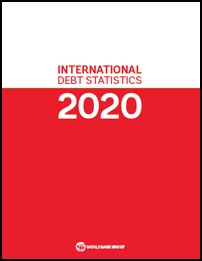External debt stock of low- and middle-income countries rose 5.2% in 2018 to $7.8 trillion, a slower pace of accumulation than in 2017, according to the World Bank’s International Debt Statistics 2020. Excluding the top ten borrowers (Argentina, Brazil, China, India, Indonesia, Mexico, Russia, South Africa, Thailand, Turkey) external debt stocks for low- and middle-income countries rose 4%.
Net debt inflows (gross disbursements minus principal payments) to low- and middle-income countries fell 28% in 2018 to $529 billion. At the same time, net financial flows (including both debt and equity) to low- and middle-income countries fell 19% in 2018, down 29% excluding China.
International Debt Statistics 2020 provides users with a summary of the key developments in external debt and other financial flows to those countries and highlights factors driving yearly changes in the data. This year’s report contains new features aimed at improving access to the underlying data.
The debt indicators suggest that debt burdens may be contributing to economic vulnerabilities.
For example, while the average external debt-to-GNI ratio of low- and middle-income countries held steady at a moderate at 26%, excluding China, which has low external debt relative to GNI (14%), the debt-to-GNI ratio of low- and middle-income countries averaged almost 35%. Also, again setting aside China, which has low external debt relative to exports (68%), the ratio of debt to exports among low- and middle-income countries was 120%.
Further, there are more countries with higher debt-to-GNI levels. Since 2009, a smaller share of low- and middle-income countries have debt-to-GNI ratios below 30% (down to 25% of countries in 2018 from 42% of countries). And over the last ten years, the proportion of countries with debt-to-GNI rations above 60% has risen to 30% and the share of countries with debt-to-GNI ratios above 100% has risen to 9%.
Another message from the data is that a slowdown in new borrowing underscores investors’ concerns about debt sustainability in some of the countries that are eligible to borrow from the International Development Association, the World Bank’s fund for the poorest countries.
Net debt flows to IDA countries rose 32% in 2018, raising external debt levels among these countries by 6% to $388 billion. Combined external debt stock among IDA countries has doubled since 2009. However, new external loan commitments by public sector entities fell almost 4% to $45.8 billion in 2018.
The report also shows that lending from non-Paris Club creditors into IDA economies has slowed. The share of new commitments from non-Paris Club bilateral creditors fell to 17% (a continued decline from 43% in 2010), while the share of new commitments held by Paris Club bilateral creditors remained steady at 12%.
This year’s report is a further step in the evolution of the document and offers improved data coverage and aims to respond to the demand for more data coverage and greater data frequency.
International Debt Statistics 2020 contains the following upgrades:
- Faster release: This year’s edition is released 9 months after the 2018 reference period, making comprehensive debt statistics available faster than ever before.
- Quarterly updates: To better assist interpretation of the data, this year’s edition will be extended to a series of IDS Quarterly Bulletins providing more data and analysis beyond the headline numbers. The bulletins will explain outcomes and trends at the regional and country-specific level and for some sub-groups.
- More detail: To increase debt transparency, this year’s edition offers a more detailed breakdown of external debt statistics: government borrowing, public sector, including all public corporations, state-owned enterprises and development banks, and private sector borrowing guaranteed by the public sector. Each of these will be associated with the creditor type for each debtor breakdown.
- New online tables: Country-level and regional-level data tables will now be available online in two formats: an analytical format that will match the country pages in the book and the standard format that this year comes with detailed statistics on commitments, debt stocks, disbursements, principal payments and interest payments by debtors and creditors.
- Better data access: Using World Bank Data API, this year we have created step-by-step guides in both Python and R.
To access the IDS report and related products:
- Download the full publication (PDF)
- Download or query the database
- Visit the IDS 2020 Products Page
- Access the statistical tables
- Visit the debt portal for a range of related content
- View the “about the data” section for a full description of the concepts and definitions in IDS
Tools to access, explore, and interact with the IDS2020 are available at http://data.worldbank.org/products/ids and include:
- Full text of the IDS as a PDF file (7 Mb), also accessible from the Open Knowledge Repository (OKR)
- The World Bank’s main data website, http://data.worldbank.org, in five languages: English, French, Spanish, Arabic, and Chinese.
- The DataBank query tool which allows users to create, save, and share tables, charts and maps, and embed them on webpages: http://databank.worldbank.org
- Statistical tables and metadata presented by IDS section: http://datatopics.worldbank.org/debt/ids/
- Debt portal as the central hub for information on debt statistics through three databases: http://datatopics.worldbank.org/debt/
- The Data Helpdesk responds to frequently asked questions about World Bank data and lets users submit new questions: https://datahelpdesk.worldbank.org



Join the Conversation